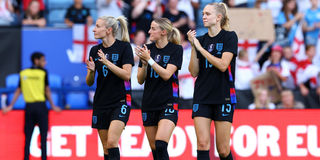ACL injuries continue to plague women's football

England's Leah Williamson, Chloe Kelly and Esme Morgan applaud fans after their international friendly match against Jamaica at King Power Stadium, Leicester, Britain on June 29, 2025.
Manchester, England
Leah Williamson was on top of the world in early 2023, playing the best football of her career for Arsenal and England and featured in advertisements ahead of the 2023 Women's World Cup, when a torn anterior cruciate ligament forced her to a screeching halt.
The 28-year-old was one of almost 30 players that missed that World Cup due to ACL injuries. She is among numerous players whose knee injuries have amplified the conversation around ACL tears, which have caused turmoil in the women's game because of the huge toll they take on players and teams.
While Williamson made a full recovery and is back to lead England at the European Championship that kicks off on Tuesday in Switzerland, the injury remains a hot topic, with Spain's Teresa Abelleira, Ramona Bachmann of Switzerland and England's Ella Morris among players out of the Euros with ACL tears.
Sophie Ingle was named to Wales' squad despite the fact she has not played since she tore hers in September.
"ACL injuries have existed as long as women's football has existed," Alex Culvin, the Head of Strategy and Research for Women's Football at global players union FIFPRO, told Reuters. "It's really important that we prioritise ACL injury. It's a holistic injury and affects players' careers in a holistic way.
Career opportunities
"Not only do they miss a minimum nine months, in a career of 10 years you're twice, three times as likely to do another ACL injury. And then you've got to think about the commercial opportunities and the career opportunities that players lose through this injury.
"Take Leah Williamson, she was Nike's poster person, and then next minute she's not playing. She obviously has come back and is an outstanding player, but the commercial and career opportunities that she loses in that snap second..."
While studies show there has not been an increase in ACL injuries in women's football over the last 20 years, and ACLs only account for 2% of time-loss injuries in elite women's football, women are up to eight times more susceptible to suffer the injury than their male counterparts.
Australia and Chelsea striker Sam Kerr, considered one of the best goalscorers in the game, is one of the staggering 500-plus elite female players who have torn their ACLs since 2022. She suffered the injury in early 2024, and has not played since.
While an elite women's team can expect one ACL injury per season, Arsenal were severely impacted when they lost four players, including Williamson, over six months in 2022-23.
Forward Beth Mead was one of the four. She also missed the 2023 World Cup but is back with England at the Euros, dedicating the tournament to her late mother June, who died of cancer two months after Mead tore her ACL.
She has been vocal about her mental health struggle which is already an issue for players during ACL recovery, but was amplified with the death of her mum.
"Because of the injury I couldn't play football, which was always my escape, my happy place," Mead said. "Moments when people thought I was fine because of my outgoing personality, were very dark."
Many factors
Culvin, who is also a senior lecturer at Leeds Beckett University, stressed research into ACL injuries must look at the bigger picture.
"People want a quick fix, and what we're saying is ACL injury is multifactorial," she said. "We can't say it's workload, or we can't say it's the way women run or they land, or they jump, or whatever it is. We're saying that there's so many factors that go into it that it's really hard to determine one or two factors, we want to look at in a holistic sense."
Culvin is part of Project ACL, a three-year study launched by FIFPRO, the Professional Footballers' Association, Nike and Leeds Beckett University that is focusing on England's Women's Super League, but plans to expand to study other leagues as well.
"There's a mismatch between levels of professionalization and the expectations on players to perform in substandard environments. And the big one for us is looking at environments as modifiable risk factors," she said.
"Obviously you've got non-modifiable risk factors which are predominantly physiological, but you've got modifiable risk factors which count for calendar, number of games, travel and then actual physical environments that players play in, and the working environments, and that's what our focus is for this research."
A FIFA-funded study at Kingston University is investigating whether fluctuations during menstrual cycles could be contributing to the career-threatening knee injuries.
While experts discount the notion of an epidemic in elite football, UEFA's chief medical officer Zoran Bahtijarevic said numbers are on the rise at the youth level as girls flock to the game.
A recent study by Nielsen Sports and PepsiCo found that player growth among girls has soared, particularly in Asia, with China seeing a 300% rise, and Europe, led by France at 150%.
"We can expect an epidemic of ACL injuries somewhere else, below the radar, with the explosion of participation," Bahtijarevic told Reuters. "The peak of injuries in women is between ages of 15-16 and 19. These go undetected, because these girls are not big stars."

